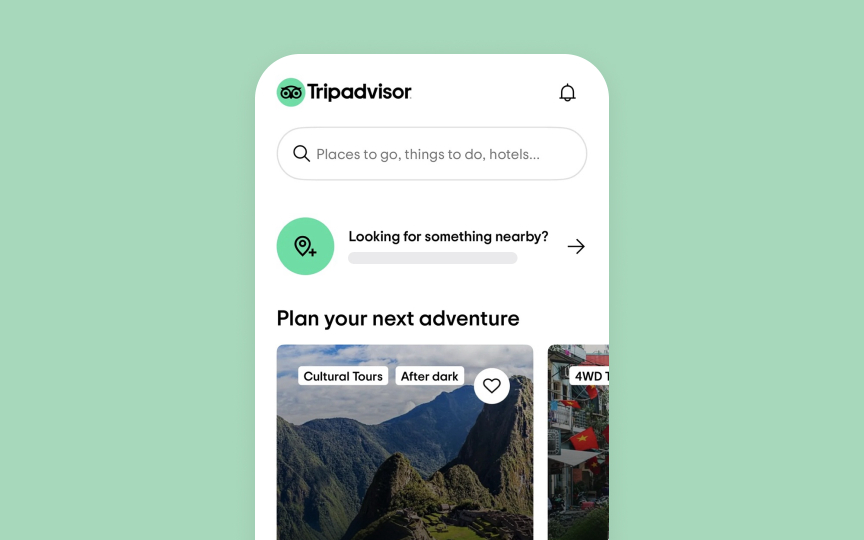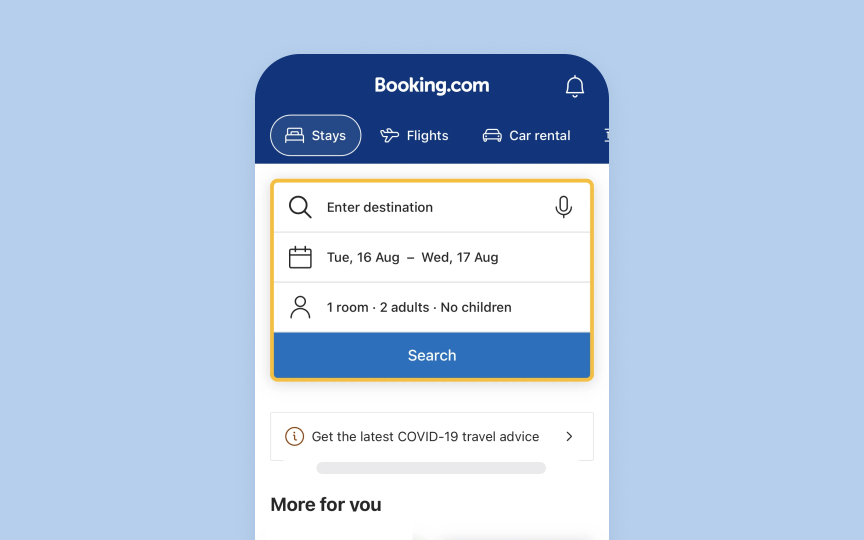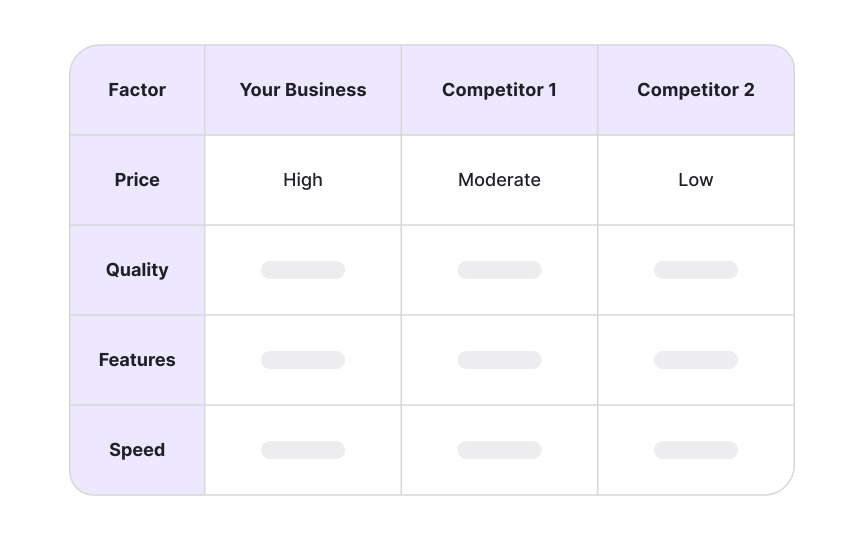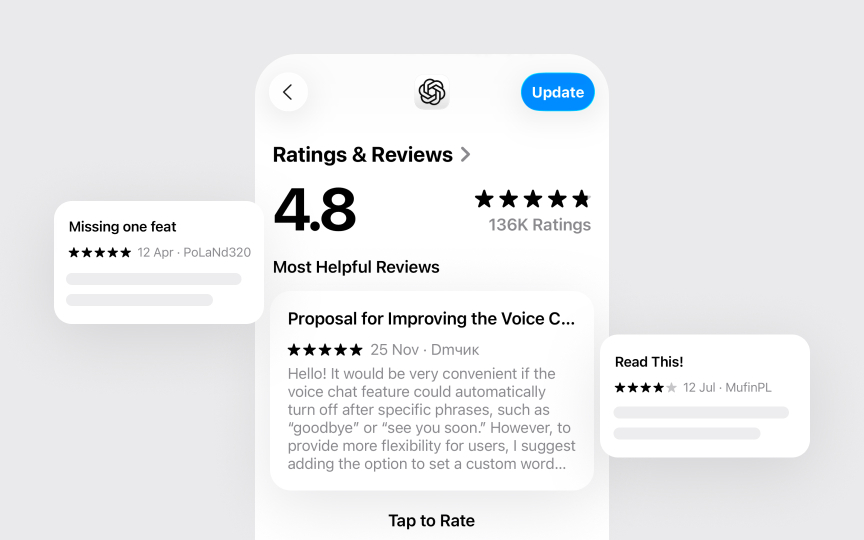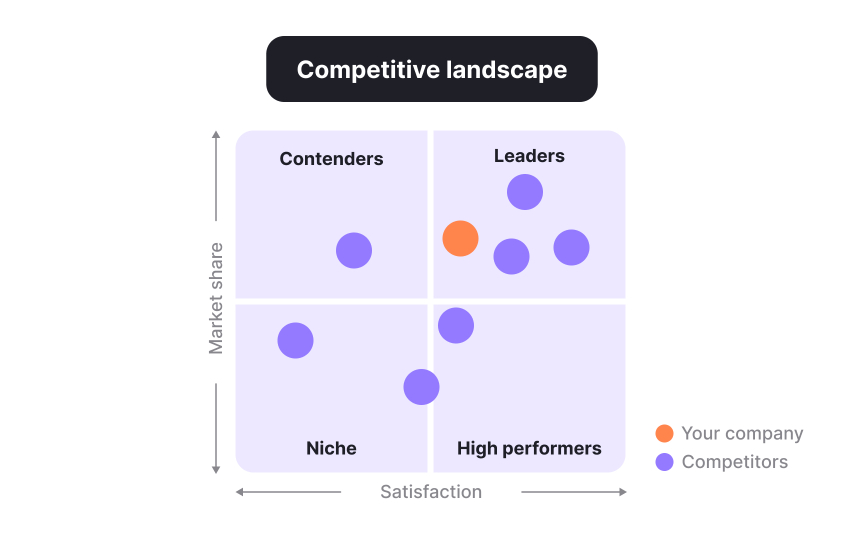Market Research and Competitive Analysis
Discover how to analyze markets and competitors to build products with a real edge.
Every product exists within a market full of alternatives. To succeed, you need to understand that landscape, who else is competing for attention, where demand is already being met, and where unmet needs remain. Competitive analysis provides this understanding. It identifies direct competitors offering similar solutions as well as indirect competitors addressing the same problem in different ways. By comparing their strengths, weaknesses, strategies, and user feedback, you uncover both risks to anticipate and opportunities to explore.
Mapping the market landscape goes further than a simple list of rivals. It places your product idea in context, showing how it aligns with current trends, customer expectations, and emerging technologies. This positioning helps teams refine value propositions by ensuring they are not only relevant but also differentiated. For stakeholders and potential investors, such analysis demonstrates the significance of your product: why it matters, how it stands apart, and what advantage it can realistically achieve.
Tools like SWOT analysis make the process structured and actionable. By organizing insights into strengths, weaknesses, opportunities, and threats, teams can quickly spot market gaps and shape offerings that solve real problems while standing out from existing options. Done well, competitive analysis reduces uncertainty, prevents wasted effort, and creates a clearer path to adoption and growth. With this knowledge, teams can make smarter choices, avoid wasted effort, and build products that have a clearer path to adoption.
Every strong competitor analysis begins with understanding the broader industry context. Without this step, insights about individual rivals risk being misinterpreted. An industry overview frames the playing field by capturing market size, growth potential, trends, and external forces shaping how all competitors operate.
A good overview typically covers 4 dimensions:
- Define market size and growth to understand the scale and potential for expansion.
- Scan key trends and drivers, such as technological innovation, customer behavior shifts, or new business models.
- Review the regulatory and economic environment, which may create both risks and opportunities.
- Identify structural changes, like new entrants or substitutes, that could redefine categories. For example, Airbnb was not a direct hotel competitor at first, but it reshaped the entire accommodation industry.[1]
Completing this overview ensures that when you later benchmark competitors, you interpret their moves in context. A company losing market share in a shrinking segment faces different pressures than one in a growing market. By starting with a clear view of the whole industry, you make better strategic choices and avoid focusing only on narrow rival comparisons.[2]
Once the industry context is clear, the next step is mapping who you are competing against. Competitor identification goes beyond making a quick list of obvious rivals. It is about understanding the types of competition you face and how each influences your strategy. Analysts often distinguish between 3 groups:
- Direct competitors, who target the same customers with similar products. Direct competitors are the easiest to spot. Nike and Adidas, for example, compete head-to-head in sports apparel, serving overlapping segments with comparable products.
- Indirect competitors, who address the same need in a different way. Indirect competitors are less obvious but just as important. Uber and public transport both solve the problem of urban mobility, though with different models and experiences.
- Aspirational competitors, whose practices you may want to learn from or surpass. Aspirational competitors include companies outside your immediate category that set benchmarks for customer experience or innovation. For a fintech startup, this could mean studying how Amazon designs seamless checkouts rather than focusing only on other payment apps.
To identify competitors effectively, combine market research with user insights. Tools like Google Trends, SEMrush, or SimilarWeb help uncover which brands users search for and how much digital attention they attract. Customer surveys and interviews often reveal alternative solutions that teams overlook internally. Mapping these perspectives ensures you capture the full competitive landscape, not just the obvious players.[3]
Competitor analysis is the process of studying other products that solve the same problem as yours to see how they create value and where they fall short. A complete view requires looking at both direct competitors, who serve the same audience with a similar offer, and indirect competitors, who address the need differently. For instance, a fitness tracking app may compete directly with Strava or Fitbit, while its indirect rivals could include paper journals or personal trainers.
When analyzing a competitor, gather practical details that matter to users:
- Examine core features, pricing strategies, and the design or usability of the product.
- Read customer reviews to identify frustrations or recurring praise.
- Pay attention to how the brand positions itself: is it selling speed, quality, affordability, or community?
- Organize this information into a short profile with key points on the target audience, main features, and pricing.
This structured view allows you to compare competitors side by side and uncover patterns you can learn from.[4]
Customer reviews are one of the richest and most underused sources of competitive insight. Unlike marketing claims, which are polished and strategic, reviews capture raw experiences from real users. They reveal both the perceived strengths that win loyalty and the frustrations that push people away. Mining this data allows you to see not only what features matter but also how customers evaluate value,
The breadth of online sources makes this practice especially powerful. App stores, Amazon listings, G2, Trustpilot, or even social media comments all contain signals about what users praise or complain about most.
The key is to analyze patterns rather than isolated comments. If dozens of reviews mention confusing navigation, that signals a structural weakness, not a single unhappy customer. Positive patterns are just as telling. A recurring theme of “fast delivery” or “responsive support” indicates a strength competitors may struggle to match. By mapping these patterns across rival products, you can see which areas are already saturated with user satisfaction and which offer opportunities for differentiation.
Not all competitors deserve equal attention. Prioritizing competitors helps you focus on those whose moves matter most, instead of spreading your analysis thin across dozens of players. A well-prioritized list is essential for planning where to invest resources.
One common approach is to rank competitors into tiers:
- Primary competitors are the ones that most closely match your product and audience, and their strategies will directly affect your success.
- Secondary competitors overlap with you partially, perhaps serving a different customer group or focusing on adjacent features.
- Tertiary competitors may not compete with you today but could become relevant as they expand or as trends shift.
For example, for Spotify, Apple Music is a primary competitor, YouTube is secondary, and TikTok could be tertiary, since its growing role in music discovery could disrupt the industry.
Visual tools like a competitor landscape graph help bring this prioritization to life. By mapping companies along axes such as
A SWOT analysis is a structured method for evaluating both the internal situation of a business and the external factors that affect it. It is most useful in the early stages of product planning, before major investments are made, and later when revisiting strategy in a changing market. Teams use SWOT to understand where they stand compared to competitors, identify areas for growth, and anticipate risks that could slow progress.
The framework is divided into 4 categories:
- Strengths are internal advantages, such as a recognizable
brand , a skilled team, or an especially loyal user base. - Weaknesses are internal limitations that reduce performance, like poor visibility in
search results, limited features, or slow customer support. - Opportunities come from outside the company and may include emerging technologies, growing market segments, or shifts in consumer behavior that create demand.
- Threats are external risks, such as aggressive new competitors, economic downturns, or changing regulations.
By collecting information in each quadrant, you create a balanced view of the product’s position. Strengths and weaknesses show what you can control directly, while opportunities and threats highlight factors in the environment that you must respond to. Together, they give you a clear picture of where to focus resources and how to stand out in a competitive market.[5]
Competitive analysis is not complete until you translate findings into strategic implications. Knowing your competitors and what users think of them is valuable, but the real impact comes from understanding how these insights shape your own choices.
One way to structure this is by looking at 3 levels of implication:
- At the feature level, competitor strengths and weaknesses highlight where you must match the standard and where you can differentiate. For instance, if all major rivals in a food delivery market offer real-time tracking, failing to include it puts you at a disadvantage.
- At the positioning level, competitor
branding and messaging reveal how crowded certain narratives are. If multiple fitness apps sell themselves as “the simplest option,” you may gain more traction by emphasizing personalization or expert credibility instead. - At the strategic level, industry shifts and competitor experiments can signal bigger moves. Airbnb’s success forced hotels to rethink not only
pricing but also the entire guest experience.
The goal is to avoid treating analysis as a static report. Instead, it becomes a decision-making lens. Which competitor moves require an immediate response, and which ones represent long-term trends you should prepare for? Which gaps point to innovation opportunities rather than risks? Mapping implications in this way ensures that your strategy remains proactive, not reactive.
References
Topics
From Course
Share
Similar lessons

Understanding User Needs and Pain Points

User Research and Personas

